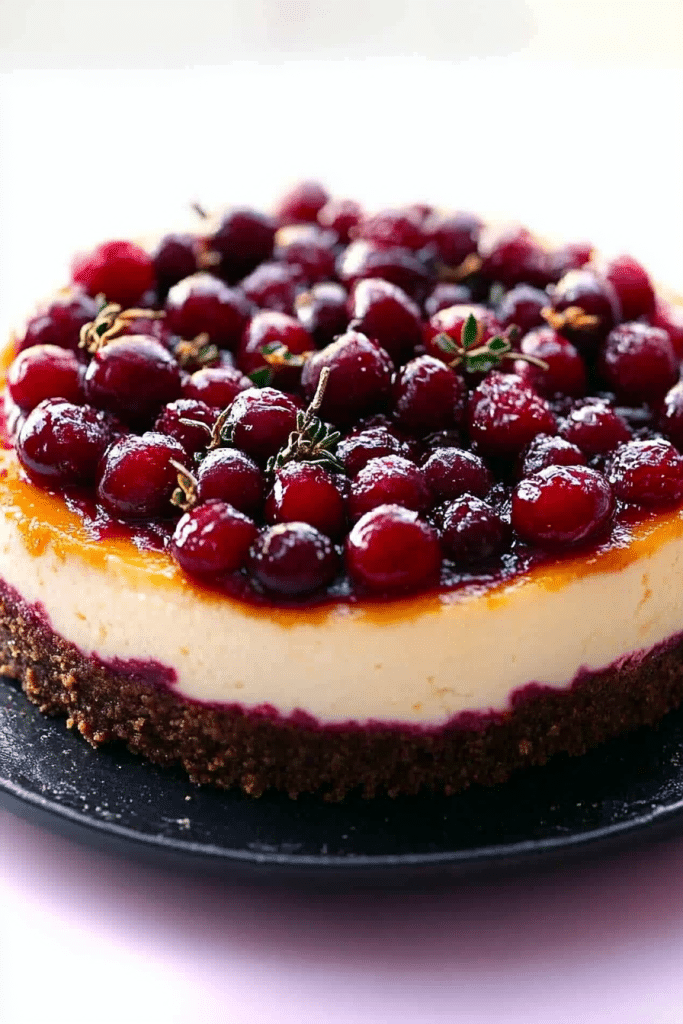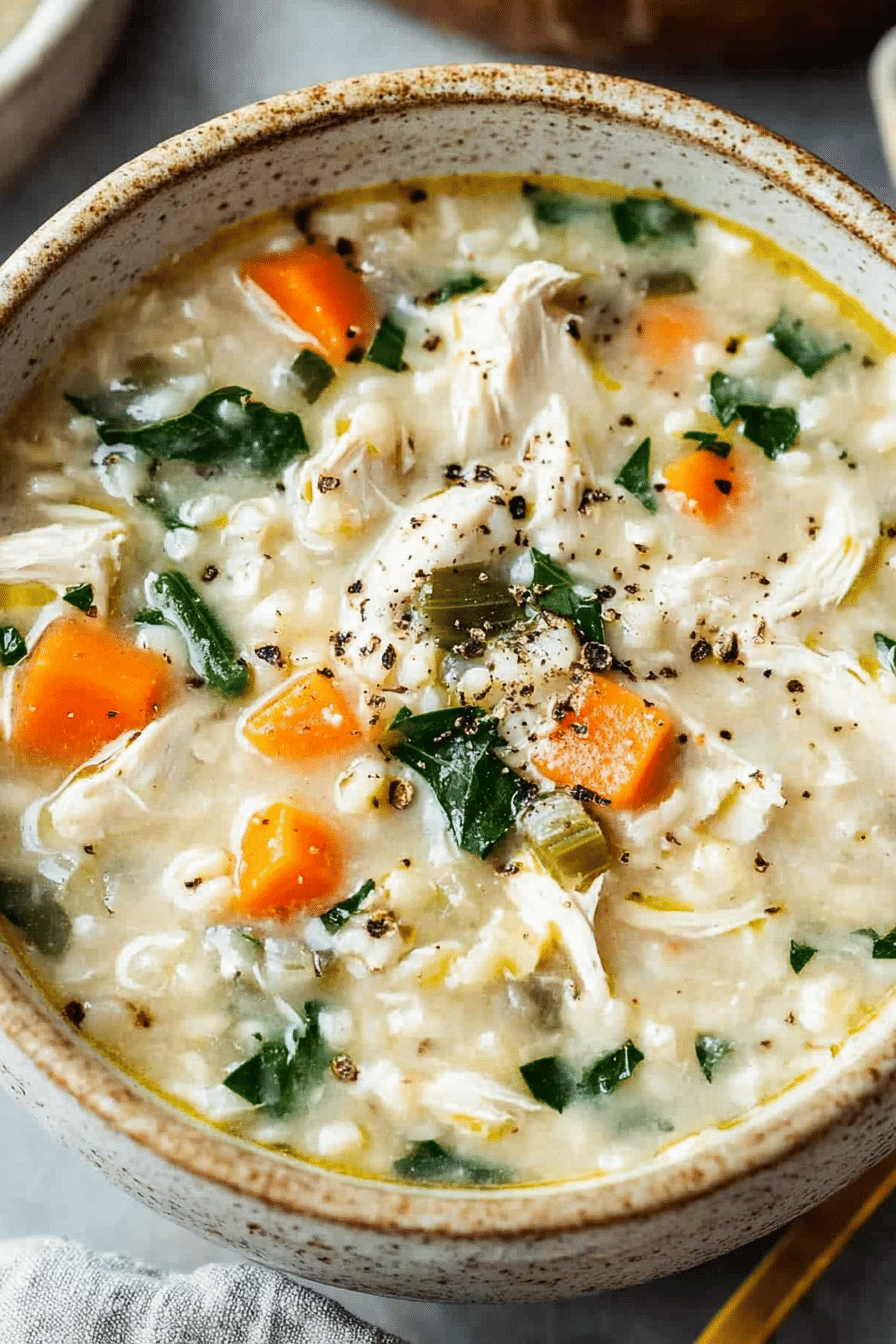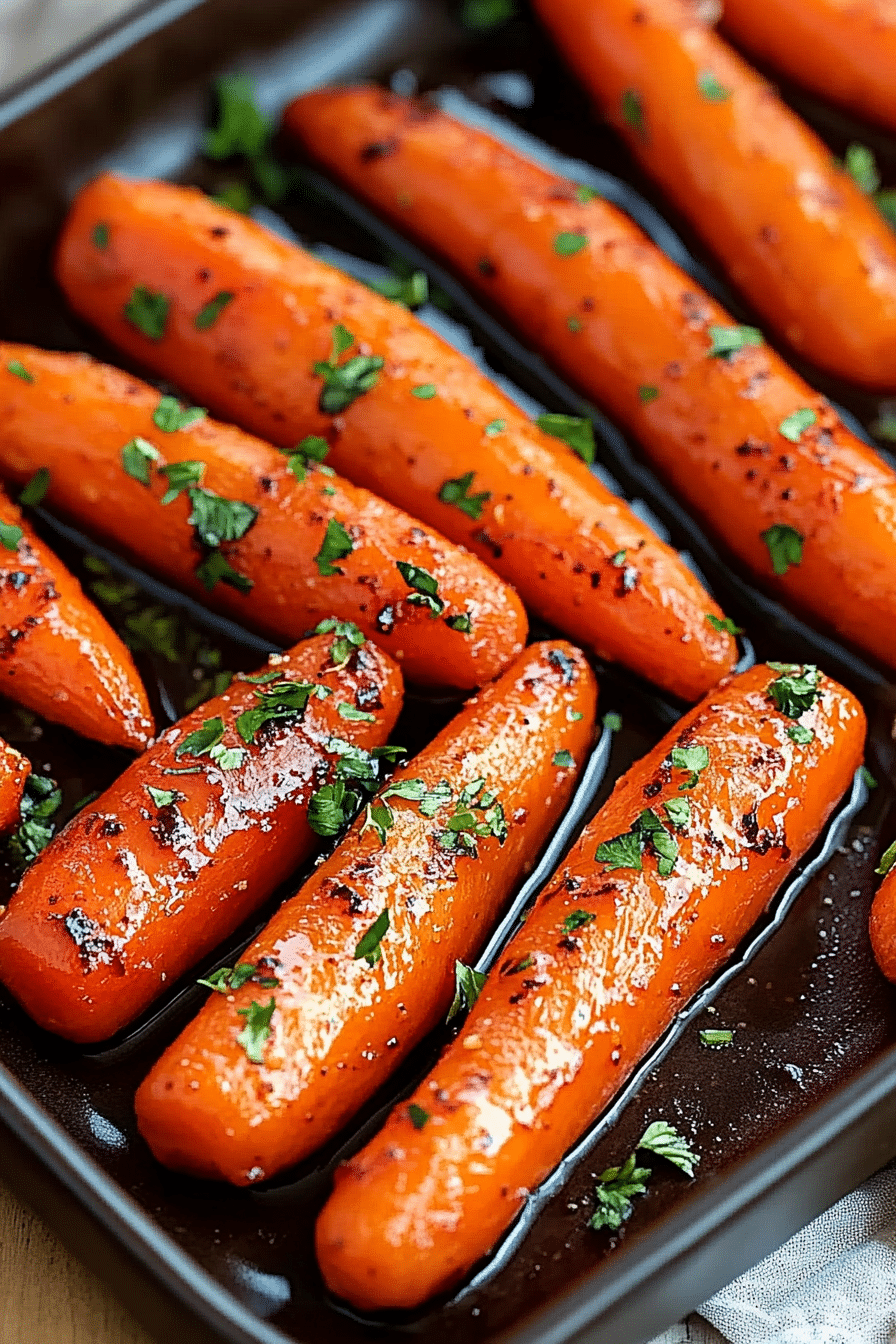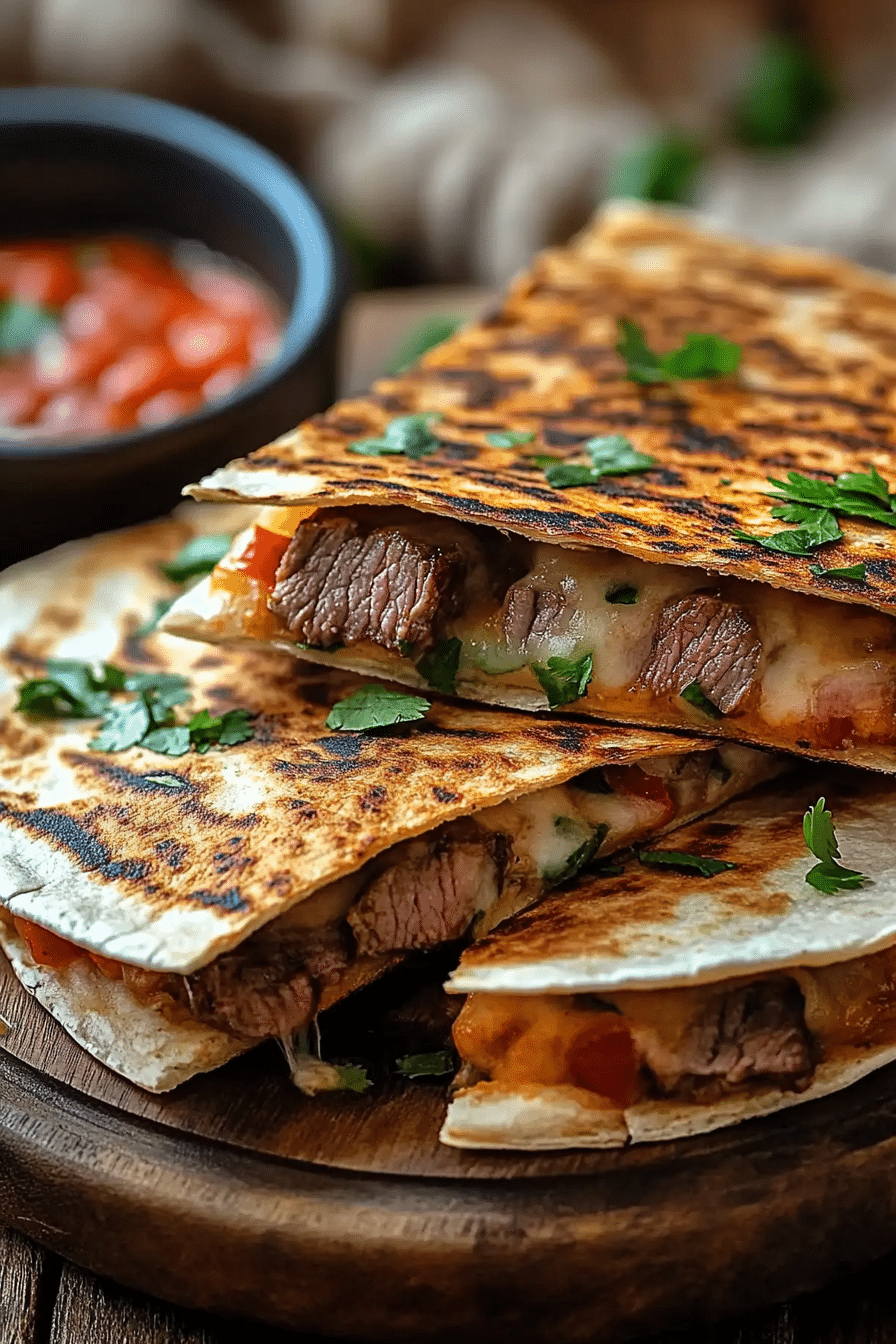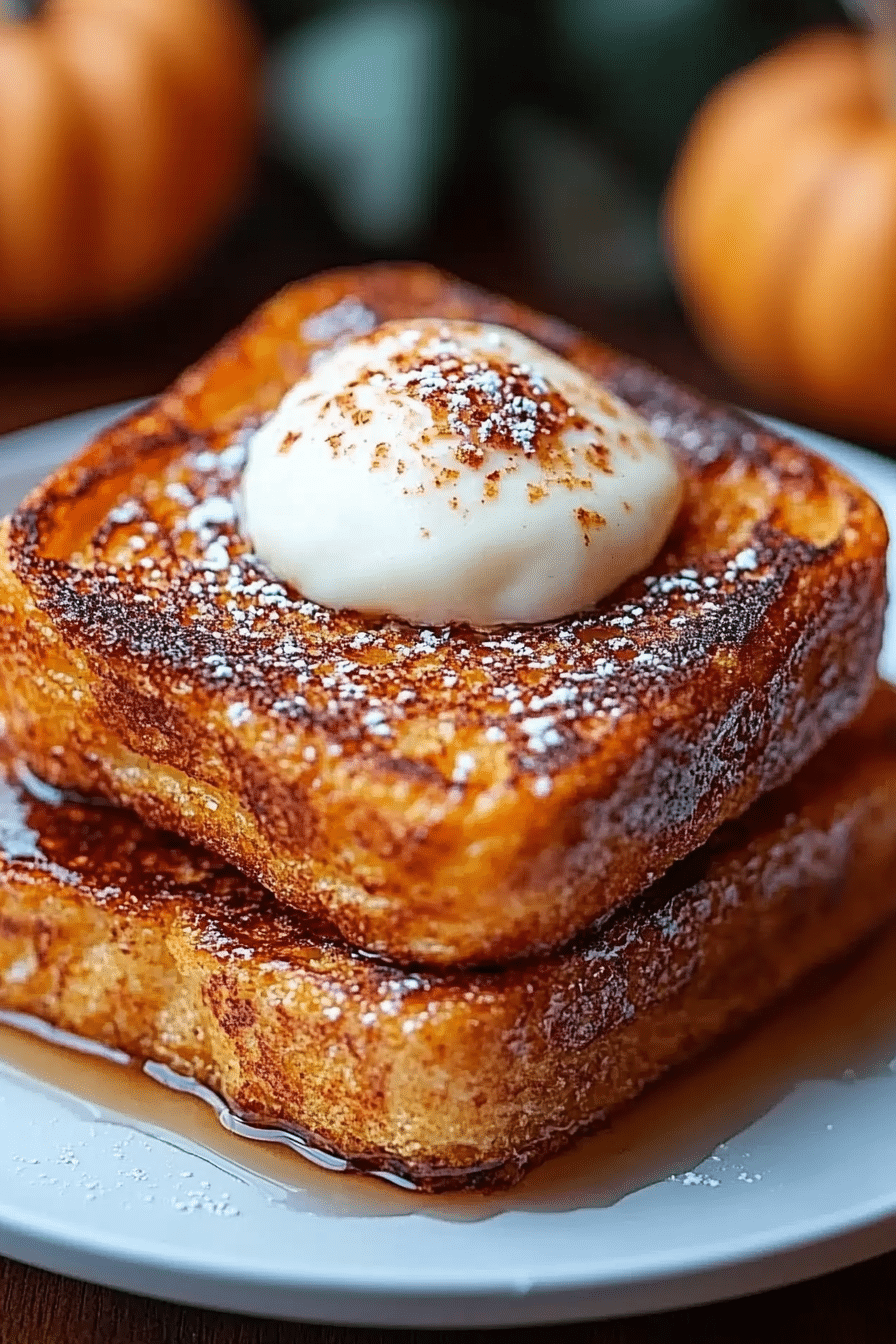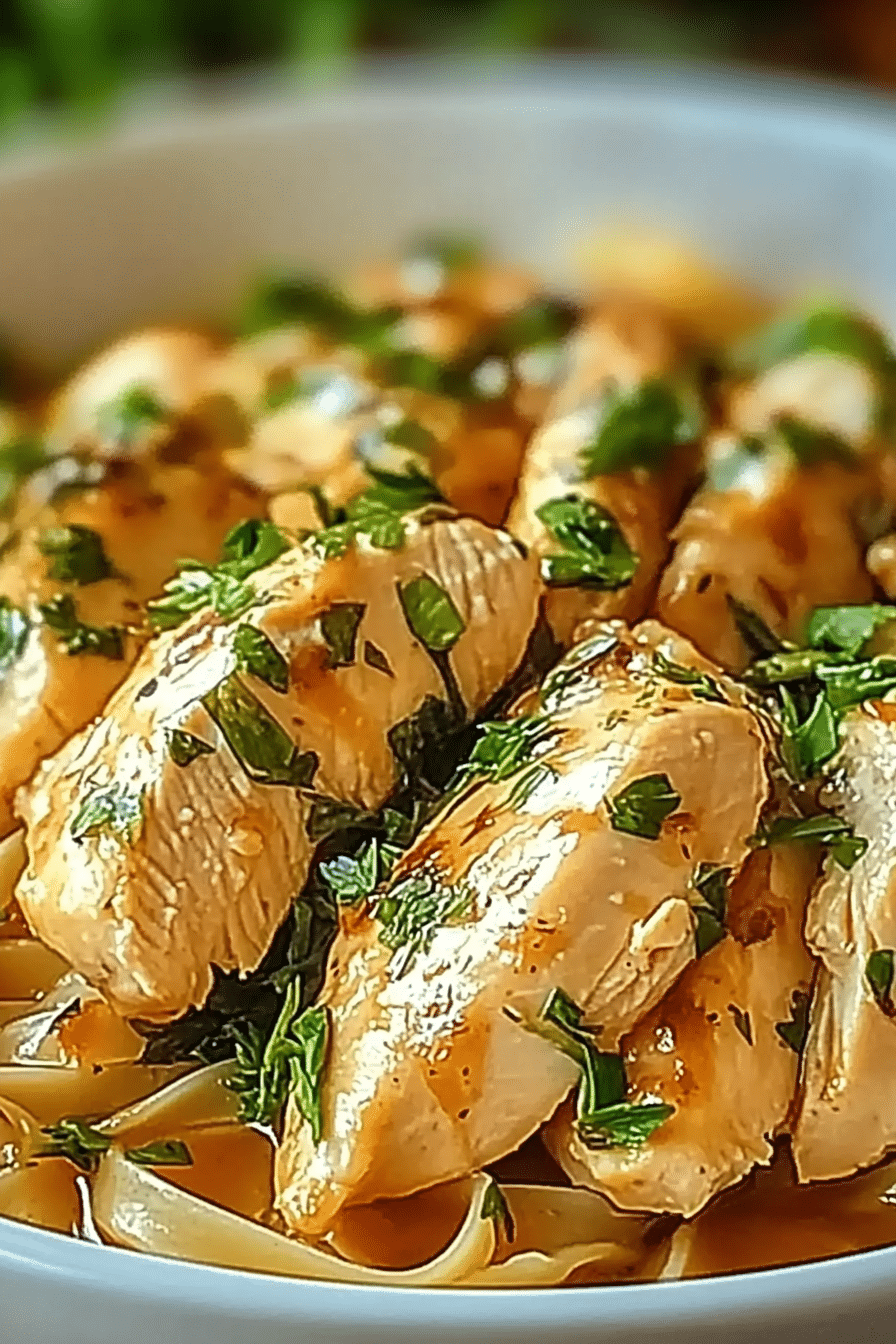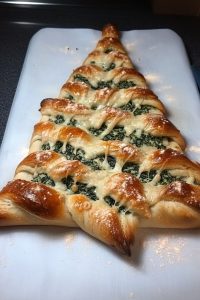I still remember the way the kitchen smelled the first Christmas our family gathered around the table with mismatched mugs and everyone talking at once. The citrusy zing of orange mingling with tart cranberries was the heart of our holiday bake, and this Cranberry Orange Cheesecake has become the grown-up version of that memory—soft, creamy, a little tangy, and somehow always earned a chorus of “is there leftovers for tomorrow?” This flavor combo is bright without being too sweet, and the texture—oh, the texture—creamy enough to melt on the tongue but firm enough to slice cleanly. It’s not complicated, which is why I reach for it on busy weeknights when I want something that feels special without taking all night. If you’ve got a go-to cheesecake, this one slides in beside it with a citrus glow that makes it feel like a celebration.
Thank you for reading this post, don't forget to subscribe!What is Cranberry Orange Cheesecake?
Think of Cranberry Orange Cheesecake as a sleek, modern take on a classic cheesecake, with a cranberry-orange glaze that adds a tart-sweet punch and a pop of color. It’s essentially a velvety vanilla cheesecake baked on a buttery crumb crust, crowned with a glossy cranberry-orange glaze that catches the light and your attention. The name tells you almost everything: cranberry for brightness and a hint of tartness, orange for sunshine and aroma. It’s not just a dessert; it’s a little moment in a slice—like biting into a memory you’ve saved for years. I love how the filling stays creamy and holds its shape without leaning to loose or crumbly, and that glaze brings in that fruit-forward finish that makes you smile with every bite.
Why you’ll love this recipe?
What I love most about this Cranberry Orange Cheesecake is the way it balances comfort and brightness in one bite. The flavor profile is memorable without being overpowering—the cranberry provides a gentle tart note that wakes up the palate, while the orange zest and glaze give a sunny aroma that fills the kitchen as it bakes. The texture is a real dream: the crust stays crisp against the creamy interior, and the filling is smooth, not grainy, thanks to room-temperature ingredients and careful mixing. This recipe is a lifesaver on busy nights because you can prep the crust, filling, and glaze ahead of time, then bake the moment you’re ready. It’s budget-friendly too, since pantry staples like crackers, cream cheese, and fruit glaze are typically on hand. If you’re craving a show-stopper that doesn’t require pastry-level finesse, this is your go-to. And if you’ve loved my other cheesecake tutorials, you’ll notice a similar creamy backbone with a fruit-forward twist that pairs beautifully with coffee or dessert wine.
- Flavor: The cranberry tang with orange brightness creates a balanced, memorable finish that lingers after the last bite.
- Simplicity: The crust can be made in a snap, and you can assemble the filling quickly if you have all the ingredients measured
- Cost-efficiency: It relies on pantry staples and a few fresh accents, so you aren’t breaking the bank for a showy bake.
- Versatility: Serve it as a refined dessert, pair with yogurt for a brunch twist, or use smaller portions for a light finish to a holiday meal.
What I’ve learned over the years is that this cheesecake shines when you treat the filling like a velvet cushion—soft, uniform, and easy to pour. If you’ve got a few extra cranberries on hand after a party, a quick simmer with sugar and a splash of orange juice makes a radiant glaze you can spoon over the surface for a glossy finish. For an extra cozy variation, I sometimes fold a teaspoon of vanilla into the filling and swap a portion of the orange zest for lemon zest—it brightens without changing the core personality of the dessert. If you’ve never baked with fresh cranberries, I recommend tasting a small sample as they cook down; they can surprise you with how tart they become, and that’s what makes the glaze sing.
How to Make Cranberry Orange Cheesecake
Quick Overview
Here’s the quick version before we dive in deeper: prep a buttery crumb crust, beat a smooth cream cheese mixture with a touch of vanilla and sugar, pour it over the crust, and bake low and slow until just set. While it cools, simmer cranberries with orange juice and a hint of sugar to make a glossy glaze. The result is a cheesecake that’s luscious in the middle, with a crisp edge from the crust, and a glaze that snaps when you cut through. It’s the kind of dessert that looks impressive in photos but is actually quite forgiving in practice. Trust me on this one—the slow bake helps the center stay creamy rather than jiggly, and a proper cool-down is non-negotiable for clean slices. If you’ve got a busy schedule, you can assemble the crust and filling up to a day ahead and refrigerate, then bake when you’re ready.
Ingredients
For the Main Crust & Batter:
- 1 1/2 cups graham cracker crumbs (or digestive biscuits for a crisper bite)
- 1/4 cup granulated sugar
- 6 tablespoons unsalted butter, melted
- Pinch of salt
For the Filling:
- 24 ounces (three 8-ounce packages) cream cheese, softened
- 3/4 cup granulated sugar
- 3 large eggs
- 1 teaspoon vanilla extract
- 1 tablespoon fresh orange zest
- 1/2 cup sour cream, for extra silkiness (you can swap with Greek yogurt for lighter creaminess)
- 1/4 cup heavy cream
- 1/2 cup fresh cranberries, roughly chopped (or use frozen, thawed and drained)
For the Glaze:
- 1 cup fresh cranberries
- 1/2 cup orange juice
- 1/4 cup sugar
- 1 tablespoon lemon juice
- 2 teaspoons cornstarch dissolved in 2 tablespoons water
Notes & sourcing tips: If you can find a good almond-graham cracker combo, it adds a nice toasty note without overpowering the filling. I often pulse the crackers to a fine crumb for a smoother crust, but a few larger pieces are a lovely textural surprise. Fresh cranberries are best for the glaze, but if you’re out of season, you can use frozen cranberries (do not thaw completely; drain well and pat dry). For the filling, room-temperature ingredients are your best friend—they blend into a silkier emulsion. If you’re dairy-free, I’ve tested a version with full-fat coconut cream and a touch of dairy-free cream cheese; it’s not identical, but it’s a delicious, allergy-friendly spin-off.
Step-by-Step Instructions
Step 1: Preheat & Prep Pan
Preheat your oven to 325°F (165°C). Lightly butter a 9-inch springform pan and line the bottom with parchment for easy release. Wrap the outside of the pan in a couple of layers of foil to protect the crust from any leaks if your pan isn’t perfectly sealed. I know this feels fussy, but trust me—it saves you from a soggy crust and a mess in the oven. Set the pan aside while you prepare the crust.
Step 2: Mix Dry Ingredients
In a medium bowl, mix graham cracker crumbs, sugar, and a pinch of salt. The goal is even distribution of sweetness and a little bite from the salt to counter the sweetness. I like to rub the crust between my fingers for a moment to wake up the crumbs, which helps them absorb butter more evenly later.
Step 3: Mix Wet Ingredients
In a separate bowl, beat the cream cheese until it’s smooth and free of lumps. Add sugar and beat until light and fluffy—this is where the cheesecake starts to turn lush. Beat in eggs one at a time, then stir in vanilla, orange zest, sour cream, and heavy cream. You want a glossy, even batter; avoid overmixing once the eggs go in to prevent cracks and a tough texture. A good tip is to stop mixing as soon as you see the batter come together—it’s easy to overwork cream cheese, and you’ll thank yourself afterward.
Step 4: Combine
Fold the dry ingredients into the wet with a gentle hand, just until combined. The batter should be smooth and thick but pourable—not stiff. If you see a few lumps, that’s okay; you don’t want to overwork it in an effort to hit a perfectly smooth batter. Fold in the chopped cranberries so they’re distributed but not all in one clump.
Step 5: Prepare Filling
Pour the filling into the prepared crust, smoothing the top with a spatula. If you want extra flair, you can add a few whole cranberries pressed into the surface for a holiday look. This is the moment to adjust flavor: a pinch more orange zest can brighten the whole thing, or a splash more vanilla can deepen the vanilla notes for a cozier finish.
“The Cranberry Orange Cheesecake turned out amazing. My kids asked for seconds. Saving this one!”
Step 6: Layer & Swirl
For a subtle swirl, you can drop a couple of tablespoons of bright orange marmalade into the batter then use a skewer to swirl lightly. I don’t want to over-swirl because you’ll lose that creamy center, but a tiny ribbon of color is pretty and adds a hint of extra citrus aroma as the cheesecake bakes.
Step 7: Bake
Place the pan in the center of the oven and bake gently for 60–70 minutes. You’re aiming for the edge to set and look slightly puffed, with the center still a touch jiggly but not liquid. If the top is browning too quickly, cover loosely with foil for the last 15–20 minutes. The slow bake helps the center stay creamy and the surface to have that perfect, smooth sheen. When done, turn off the oven and let the cheesecake rest inside with the door cracked for about an hour; this technique reduces cracking and helps the texture set evenly.
Step 8: Cool & Glaze
Remove the sides of the springform and let the cheesecake cool completely on a rack. Then chill for at least 4 hours, preferably overnight—the flavors blossom with time. Meanwhile, simmer the glaze: cranberries, orange juice, sugar, and lemon juice simmer until the berries pop and the sauce thickens. Stir in the cornstarch slurry and cook a minute or two more until glossy. Coat the cooled cheesecake with the glaze just before serving, letting it cascade down the sides for that irresistible shine. If you’re not ready to glaze, you can refrigerate with the glaze on standby and add it right before slicing for the freshest look.
Step 9: Slice & Serve
Run a knife around the edge before removing the foil and slicing. A warm knife (rinse and wipe between cuts) helps produce clean slices. I like to wipe the blade after every cut for truly neat portions. This Cranberry Orange Cheesecake pairs beautifully with a dollop of whipped cream and a few extra fresh cranberries for garnish. It’s equally delicious with a cup of strong coffee or a glass of late-harvest dessert wine. My friends always say the slice looks like a little jewel on the plate, which makes the whole kitchen feel festive even on a Tuesday.
What to Serve It With
This cheesecake is a little conversation starter, so think about presentation and contrasting textures. It’s delicious with a few smart, simple accompaniments that don’t overpower the bright cranberry-orange notes.
For Breakfast: A thin slice with a dollop of yogurt, a drizzle of honey, and a hot cup of black coffee. It’s surprisingly refreshing on a Saturday morning.
For Brunch: Pair wedges with a light sparkling beverage and orange-scented whipped cream. A few toasted almonds scattered on top add a nice crunch.
As Dessert: Serve with extra fresh cranberries and an optional mint sprig for color. A light dusting of powdered sugar is a quick, elegant finish.
For Cozy Snacks: Cut into smaller squares and serve with warm tea or a mug of mulled cider. It’s the kind of treat that makes a house feel like a hug.
When my kids were little, we’d bake this on Sunday afternoons and the house would fill with that sweet citrus aroma. They’d stand at the counter, chin on the edge, waiting for a slice as the glaze cooled—I’d tell them to be patient, and they’d promise to be “extra careful” with the knife. It’s those tiny rituals—the way the glaze catches the light, the soft crackle of the crust as you press a slice—that make this Cranberry Orange Cheesecake a family favorite. If you’ve got your own little rituals, share them in the comments below; I always love hearing how families personalize this one.
Top Tips for Perfecting Your Cranberry Orange Cheesecake
Here are a few practical, no-nonsense tips that have saved me more than once in the kitchen.
Crust Prep: Make sure your crust is evenly pressed and compact. A gentle tapping on the pan helps settle the crumbs and prevents shifting during baking. If you pinch the edges a little higher, the sides stay crisp and you get that classic cheesecake silhouette. If you want a gluten-free option, swap in gluten-free crackers or biscuits and add a touch more butter to help the crust hold together.
Mixing Advice: Cream cheese should be completely softened; otherwise you’ll fight lumps. Beat thoroughly at a medium speed until silky, then add sugar and vanilla gradually. Overmixing after the eggs go in makes the texture dense—stop as soon as you see the batter come together for a smooth finish.
Swirl Customization: If you love beautiful swirls, drop spoonfuls of orange curd or marmalade across the surface and very gently swirl with a toothpick. Don’t overdo it—the goal is a hint of color, not a marble show.
Ingredient Swaps: For a lighter version, swap half of the cream cheese for ricotta or mascarpone, or use part-skim dairy to reduce fat. If you want extra citrus, add a teaspoon more orange zest and a splash of orange liqueur. For a dairy-free version, use dairy-free cream cheese and coconut cream, but expect a slightly different texture and flavor profile.
Baking Tips: Bake low and slow at 325°F, and resist the urge to peek too often. Any fluctuations in oven temperature can crack the surface or alter texture. If your oven runs hot, you may need to reduce the bake time by 5–10 minutes and shield the top with foil in the final stretch.
“I don’t know if I’ve ever eaten a better Cranberry Orange Cheesecake. The rub alone is wonderful, but the sauce??? Over the top!”
Glaze Variations: You can add a splash of orange liqueur to the glaze for more depth, or swap in cranberry juice for a thinner, brighter glaze. If you want to keep it glossy but less sweet, brush a thin layer of warmed jelly over the surface and let it set for a professional shine.
Lessons learned: patience in the cooling phase yields a cleaner slice and a more luxurious bite. I’ve learned the hard way that rushing the cool-down creates cracks and a less cohesive texture. This slow, patient approach is worth every minute. And if you’re ever tempted to skip the glaze, try a light dusting of citrus zest and a pinch of cranberry sugar to keep that festive look without adding extra sweetness.
Storing and Reheating Tips
Better baked goods deserve thoughtful storage so they taste just as good on day two as they did on day one.
Room Temperature: The cheesecake can sit at room temperature for up to 2 hours, covered loosely with foil or plastic wrap to protect the glaze. After that, refrigeration is best to preserve texture and flavor.
Refrigerator Storage: Store in an airtight container or tightly wrapped in plastic wrap for up to 5 days. If the glaze begins to dull, you can rewarm the slices briefly in a warm oven or microwave, just long enough to soften the center without melting the glaze.
Freezer Instructions: Freeze slices or the whole cheesecake wrapped tightly in plastic and foil for up to 2–3 months. Thaw overnight in the refrigerator and bring to a cooler temperature before serving to maximize creaminess.
Glaze Timing Advice: If you’re storing the cheesecake before glazing, keep the glaze on standby and add it after thawing or just before serving. The glaze keeps better if applied fresh, but it’s also forgiving if you’re short on time.
Personally, I love freezing slices for quick showers of delight on busy weekday evenings. It’s the little backup plan that makes life easier, and you’ll be grateful that you baked extra when friends drop by or you just need a comforting hug in dessert form.
Frequently Asked Questions
Final Thoughts
This Cranberry Orange Cheesecake is everything I want in a dessert: creamy, bright, and a little indulgent without feeling heavy. It’s my go-to when I want to impress without stressing, and it never fails to spark a little joy around the table. If you try it, tell me what you swapped or added—I’m always curious how a small tweak can become a new family favorite. And if you’ve got a favorite cranberry-orange pairing of your own, drop a note in the comments so we can swap stories and ideas. Happy baking!
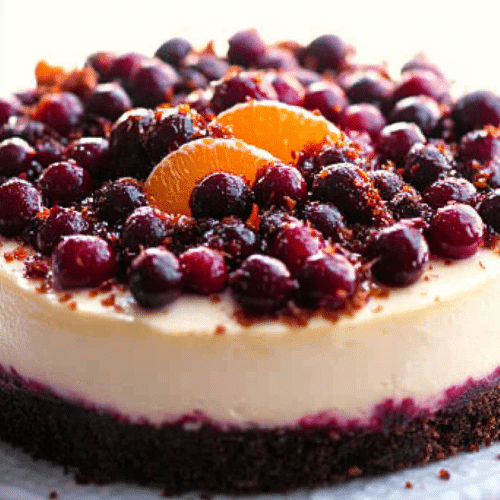
Cranberry Orange Cheesecake
Ingredients
Graham Cracker Crust
- 1.5 cups graham cracker crumbs about 10 full sheets
- 0.33 cup butter melted
- 0.25 cup sugar
Cheesecake Filling
- 4 oz orange zest about 2 oranges
- 0.75 cup fresh orange juice strained
- 2 cups cranberry sauce homemade or canned, chilled
- 32 oz cream cheese softened, at room temperature
- 1 cup sugar
- 4 large eggs at room temperature
- 1 cup sour cream at room temperature
- 0.5 teaspoon vanilla extract
Cranberry-Orange Compote (Topping)
- 1.5 cups fresh or frozen cranberries
- 0.5 cup orange juice
- 0.33 cup sugar
- 0.25 teaspoon orange zest fresher zest for bright flavor
Instructions
Crust
- Preheat oven to 325°F (165°C). In a medium bowl, mix graham cracker crumbs, melted butter, and sugar until well combined.
- Press mixture firmly into the bottom and 1 inch up the sides of a 9-inch springform pan. Bake for 10 minutes, then cool slightly.
Cheesecake Filling
- In a large bowl, beat cream cheese and sugar with an electric mixer until smooth and creamy, scraping down the sides as needed.
- Add sour cream, vanilla, and orange zest. Mix until combined. Gradually add eggs one at a time, mixing just until incorporated.
- Pour 2/3 of the batter over the pre-baked crust. Spoon dollops of cranberry sauce (about 1 cup) over the top, then swirl gently with a knife.
- Add remaining batter and smooth top. Bake for 50–60 minutes, until the edges are set and the center is slightly jiggly.
- Turn off oven, crack the door, and let cheesecake cool in oven for 1 hour. Refrigerate uncovered for 4 hours or overnight.
Cranberry-Orange Compote
- In a small saucepan, combine cranberries, orange juice, sugar, and zest. Bring to a simmer over medium heat.
- Cook for 10–12 minutes, stirring occasionally, until cranberries burst and sauce thickens slightly. Cool completely before using.
- Spread compote over the chilled cheesecake just before serving for best texture.


